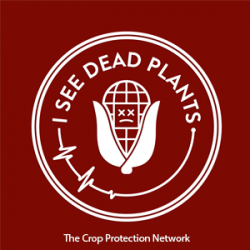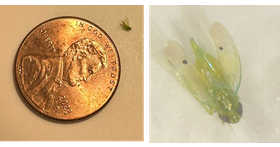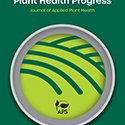
Tom Allen
@baldpathologist
Followers
5K
Following
11K
Media
2K
Statuses
11K
Extension/Research Professor and Plant Pathologist with Mississippi State University at the DREC - corn, cotton, grain sorghum, rice, soybean, and wheat
Stoneville, MS
Joined August 2009
Fusarium stalk rot causes shredded pith that may be tan to light pink. Brown streaks may be observed on the lower internodes. The fungi overwinter in corn residue, other dead plant residue, and in corn seed. Resistance to Fusarium stalk rot is available. Rotation and tillage
1
18
28
Barley yellow dwarf (BYD) of wheat is widespread throughout the U.S. and Canada. Aphids that carry the virus overwinter in winter wheat and can spread the virus to spring wheat. Varieties resistant to BYD are available. Altering planting date can help avoid virus transmission to
1
10
26
Office view 2.0: Kinda like Deja vu, but the view from a few weeks ago is a bean header
0
0
9
Cotton boll rots are caused by numerous fungi and bacteria. Identifying the primary pathogen is difficult due to non disease-causing fungi on rotten bolls. Yield losses are greater with frequent rainfall and dense crop canopies. Fusarium boll rot is the most common boll rot in
2
7
24
New Podcast Episode! Meet the cotton jassid — the tiny sap-sucking pest leaving big marks on cotton fields. We’re talking damage, detection, and how growers can stay one step ahead. 🎧 Listen here: [ https://t.co/2WzrH0U556]
#AgPodcast #Entomology #Cotton #PestManagement
1
4
8
Cotton Jassids Detected in Tensas Parish Cotton Fields
lsuagcenter.com
Cotton jassids have been found in two separate cotton fields in Tensas Parish, marking the first documented field detection of this pest in cotton within Louis
1
2
7
Symptoms caused by Soybean vein necrosis virus (SVNV) are common in Alabama. SVNV often begins as yellowing near leaf veins that develops into reddish-brown lesions that spread along leaf veins, resulting in necrosis of tissue @CropNetwork @baldpathologist @yztanet #Virus
0
5
11
Get a First Look 🔍: “Field-Scale Evaluation of Fungicide Timing for Corn Diseases and Yield in Indiana from 2019 to 2022,” by Kaitlin G. Waibel et al.: https://t.co/GONpSXXNm7
@DTelenko
apsjournals.apsnet.org
Tar spot (Phyllachora maydis), gray leaf spot (GLS; Cercospora zeae-maydis), southern rust (Puccinia polysora), and northern corn leaf blight (Exserohilum turcicum) are foliar diseases that can...
0
5
7
A great state-wide project working with our Purdue Ag Centers @PurdueAg @PurdueBPP @PurdueCorn @PurdueExtension
Get a First Look 🔍: “Field-Scale Evaluation of Fungicide Timing for Corn Diseases and Yield in Indiana from 2019 to 2022,” by Kaitlin G. Waibel et al.: https://t.co/GONpSXXNm7
@DTelenko
0
4
12
Happy World Cotton Day! We harvested our first County Demo plot today in Jefferson County. Thanks to our cooperators at Guedon Farms. #mscrops #MSUext (Will Rutland, @msuextservice associate III)
0
1
7
The 2025 Row Crop Short Course will be held at the Cotton Mill Conference Center near the campus of Mississippi State University on December 8 – 10, 2025! REGISTER: https://t.co/bNxF13KJ5I
#mscrops #MSUext
0
1
2
From historic spring rains to a challenging mid-summer dry spell, Drew shares his observations on how growers navigated a season of extremes. For more episodes from the Crop Doctors, visit our website at https://t.co/etqU1Ea8FH
0
2
5
For the record…..his string continues. We podcast with him and it rains. Yep….he’s a witch @DMGholson @JasonABond
From historic spring rains to a challenging mid-summer dry spell, Drew shares his observations on how growers navigated a season of extremes. For more episodes from the Crop Doctors, visit our website at https://t.co/etqU1Ea8FH
1
0
6
Harvest ended a year of ups and downs for Mississippi’s rice producers, with acreage up but average yield down because of numerous challenges. Read the crop report here: https://t.co/EzRs8i0LXv
#mscrops #MSUext
1
2
3
Plant pathogens caused an astonishing estimated yield loss of 560 million bushels, valued at $2.9 billion USD, between 2018 and 2021. 🌾 Read the article by @NDSUcerealpath et al. to learn more: https://t.co/71t8jM6q6B
1
27
50
Commercial Biostimulant Seed Treatments Showed Minimal Impact on Soybean Seed Yield across the United States @ColetFabiano & @StepUpSoy led @SoybeanScience1 collaboration
1
7
12
Ear rot & mycotoxin issues during #harvest25? Set the combine to harvest clean, whole kernels, as aflatoxins & fumonisins are often concentrated in light, damaged kernels. To minimize kernel damage, use the lowest possible cylinder speed necessary to shell grain effectively
0
15
24
0
10
8













